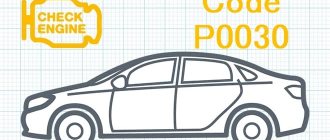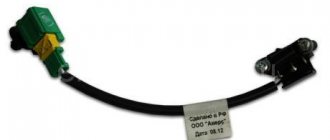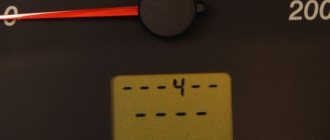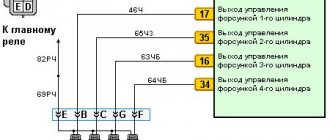No motorist will be happy to see an error when scanning the control unit. This is especially true for errors that are accompanied by the Check Engine light on the instrument panel.
It is the burning check that most often becomes the reason to inquire about what errors were recorded and stored in the memory of the control unit. Some codes contain rather warnings, recommending that consumables be replaced in the near future. Others point to the pre-accident condition of the vehicle and its individual systems.
You should find out what category error P0130 belongs to, what it means, how it manifests itself, and what will be required to eliminate it.
Causes of error P0130
The most common causes of this error are:
- Disconnecting the oxygen sensor connector
- Corroded oxygen sensor connector
- Damage to the electrical wires coming from the oxygen sensor to the ECM
- Fuel supply limitation (fuel pump malfunction or fuel filter clogged)
- Air intake system leakage
- Air or fuel system leakage
- Malfunction of the mass air flow sensor
- Malfunction of the absolute pressure sensor in the intake manifold
- Malfunction in the fuel vapor recovery system
- Oxygen sensor malfunction
- Fuel pressure regulator malfunction
- Engine control module (ECM) malfunction
Symptoms that appear
The P0130 error itself does not have characteristic symptoms that would allow us to immediately say that the problem in the engine is observed from the lambda probe. These are rather indirect signs by which you can guess to check the ECU, read the error and then understand the essence of the problem from it.
If there is a voltage problem in the oxygen sensor circuit, this will affect engine performance. Therefore, error P0130 almost never goes unnoticed.
If there is such a malfunction, you can notice it by the following signs:
- fuel consumption increases without changing the load and operating conditions, that is, fuel consumption is higher than before the error under similar conditions;
- the engine is unstable at high speeds;
- the car noticeably loses in dynamics;
- acceleration takes more time;
- actively pressing the gas pedal to the floor still does not give the expected jerk;
- The Check Engine light comes on on the dashboard.
How does a mechanic diagnose a P0130 code?
To properly diagnose the P0130 code, you will need an advanced diagnostic scanner that can not only read stored trouble codes, but also view readings from various sensors in real time.
First, the mechanic reads all the stored data and error codes using an OBD-II scanner to find out when and under what circumstances the P0130 code appeared. He will then clear the error codes from the computer's memory and test drive the vehicle to see if the P0130 code appears again.
If the error code appears again, the mechanic will continue diagnosing to determine the cause of the error. To do this he will need:
- Advanced diagnostic scanner
- Digital voltmeter
- Smoke installation for detecting leaks in the intake system
Formation conditions
In order for error P0130 to be recorded and stored in the memory of the control unit, while simultaneously producing accompanying symptoms, a certain scenario must be executed.
These are the conditions under which an error is generated, and it is recorded by the vehicle's ECU. We are talking about executing such a scenario.
The oxygen sensor, also known as a lambda probe, must be faulty for 1 minute or more, which is detected by the control unit.
When no information is received from the oxygen controller, that is, the values change too slowly, the data is erroneous, and this continues for 60 seconds or longer, then the error is recorded in the memory of the control unit.
Approximately 10 seconds after the error code P0130 is recorded in the memory of the electronic unit, everyone’s unloved check indicator appears on the dashboard. That is, Check Engine, which recommends that the motorist check the condition of the engine as soon as possible. After all, there are some malfunctions in it.
If the oxygen sensor has completely failed, that is, no signals are received from the controller, in addition to error P0130, code P0134 is often recorded in the ECU memory.
Fulfilling the appropriate conditions allows the corresponding problem to be detected when scanning the memory of the electronic control unit.
Common mistakes when diagnosing code P0130
The most common mistake when diagnosing a P0130 code is to rush to replace the oxygen sensor without first checking it.
Before replacing the sensor, it is necessary to perform a thorough diagnosis using special equipment and consider all possible causes of the error.
Since there can be multiple causes for the P0130 code, replacing the sensor may not solve the problem and may cause the code to reappear.
On which cars is this problem most common?
The problem with code P0130 can occur on different machines, but there are always statistics on which brands this error occurs more often. Here is a list of some of them:
- Alfa Romeo
- Audi (Audi a4, Audi a6, Audi TT)
- BMW (BMW E46)
- Chery (Chery Amulet, Tiggo, Fora)
- Chevrolet (Chevrolet Aveo, Cruz)
- Citroen (Citroen C4, Berlingo)
- Daewoo (Daewoo Matiz, Nexia)
- Fiat (Fiat Ducato)
- Ford (Ford Focus, Fusion)
- Geely (Geely SK)
- Hyundai (Hyundai Accent, Santa Fe, Solaris, Sonata, Tucson, Elantra, ix35)
- Infiniti (Infiniti i30)
- Iveco (Iveco Daily)
- Jeep (Jeep Wrangler, Grand Cherokee)
- Kia (Kia Rio, Sid, Sorento, Spectra, Sportage, Cerato)
- Mazda (Mazda 3)
- Mercedes (Mercedes Vito, w203, w210)
- Mitsubishi (Mitsubishi Lancer)
- Nissan (Nissan Almera, Maxima, Primera, Terrano, X-Trail)
- Opel (Opel Agila, Astra, Vectra, Zafira, Corsa, Meriva, Omega)
- Peugeot (Peugeot 206, 207, 307, 308, 406, Partner)
- Pontiac (Pontiac Sunfire)
- Renault (Renault Duster, Logan, Megan, Sandero, Fluence)
- Skoda (Skoda Octavia, Rapid, Fabia)
- Subaru (Subaru Outback, Impreza, Legacy, Forester)
- Suzuki
- Toyota
- Volkswagen (Volkswagen Golf, Jetta, Passat, Polo Sedan)
- Volvo
- VAZ 2107, 2110, 2114
- Gazelle
- Lada Vesta, Granta, Kalina, Largus, Niva, Priora
- UAZ Patriot
You can sometimes encounter other errors with fault code P0130. The most common are: P0053, P0100, P0105, P0125, P0131, P0132, P0133, P0134, P0135, P0136, P0141, P0150, P0151, P0152, P0153, P0158, P0170, P0171, P0300, P030 1, P0302, P0303, P0304 , P0314, P0325, P0400, P0443, P0500, P0507, P0560, P0600, P0740, P2251, P2297.
What repairs can fix the P0130 code?
To resolve P0130, you may need to:
- Connecting the OBD-II scanner to the vehicle diagnostic connector
- Checking for an Error Code
- Analysis of data stored in the vehicle's ECM memory
- Clearing error codes from computer memory
- Test drive your vehicle to see if P0130 appears again
- Check and, if necessary, repair or replace electrical wires or oxygen sensor connector
- Checking and, if necessary, replacing the oxygen sensor
- Check and, if necessary, replace the engine control module (ECM)
What does error P0130 mean?
This is a question of paramount importance that should be of interest to the car owner. By connecting to the control unit of a scanner or smartphone, when reading errors, you can detect code P0130.
Decoding the code P0130 means that there is low voltage in the oxygen sensor circuit.
We are talking about an oxygen sensor or lambda probe, which is located in front of the catalyst, that is, before the catalytic converter.
But understanding the meaning of error code P0130 is not enough. You also need to find out the reason for its occurrence, the reasons that provoked its occurrence, as well as current methods for troubleshooting.
Whether to do it yourself or seek qualified help - each motorist decides individually. Practice shows that in many situations it is possible to cope without outside help. Act according to the situation.
Causes and Solutions for Weak O2 Sensor Signal
To summarize about the appearance of the P0130 error and possible contributing reasons for setting the “O2 sensor circuit low voltage” code, we can advise car owners not to make hasty decisions but:
- Check the lambda probe connection connector;
- Check the oxygen sensor with a multitester (measure the resistance of the heater and the voltage at the signal terminal). Although the surest way would be to take readings with an oscilloscope;
- Check the LZ wiring for open or short circuit;
- Replace a known working oxygen sensor.
After the checks and replacement have been carried out, you need to clear the error and let the engine run in different modes, including under the conditions under which the check light came on and error P0130 was set.
Source
P0130: What does oxygen sensor circuit low voltage mean?
Trouble P0130 pops up when diagnosing a vehicle, which means the oxygen sensor circuit voltage (bank 1, sensor 1) is low.
This decoding of the code indicates a malfunction of the O2 B1 S1 sensor and in order to eliminate it, you will most likely need to change the first lambda probe, provided that there are no problems with the exhaust system. P0130: Circuit Malfunction 02 Sensor (Bank 1 Sensor 1). Decoding the low voltage error in the oxygen sensor circuit.
When does error p0130 occur?
Error code p0130 is entered into the memory of the electronic unit if, after running the engine for a little more than a minute, the engine does not respond or reacts slowly to changes, and the “check engine” warning light on the instrument panel lights up after 8 seconds. after the occurrence of a malfunction that has become permanent.
At the initial stage of failure of the control lambda probe, the error may not have those characteristic features of the behavior of the car when this malfunction occurs. Although often, usually at high speeds, the car loses traction and begins to consume more fuel.
Therefore, if you began to observe such engine operation in your car or did diagnostics with a scanner that issued code P0130, then you should first check the lambda probe and its wiring. And if the readings confirm that the first oxygen sensor is unusable, then definitely replace it.
Here, by the way, it’s worth taking only the original LZ sensor, since very often for drivers error p0130 goes away only for a while and soon appears again. Therefore, many, instead of installing the original sensor, cut out the catalyst, install a fake one and reflash the “brain”, although this is fundamentally wrong; if the catalyst is forgotten, then a number of other symptoms and errors during scanning will indicate this.
Although, along with checking the oxygen sensor, it is worth checking the mass air flow sensor and for the presence of suction in the intake after the flow meter, as well as checking the fuel pressure and for the presence of cracks in the exhaust manifold before the LZ. Such malfunctions can affect the data transmitted by the lambda to the electronic computer.
Diagnostics
Based on the reasons considered, there are not many reasons for recording error P0130 in the memory of the electronic control unit. This allows the car owner or a specialist who works on the car to quickly detect the cause and try to eliminate it.
When diagnosing, it is recommended to adhere to the following algorithm of actions:
- Always check the wires first. This is the entire length of the wiring that connects the ECU and the lambda probe installed in front of the catalyst. Please note that in most cases, if the car complies with Euro-3 standards and higher, it will have 2 oxygen sensors installed. One is at the inlet, and the other is at the outlet, that is, after the catalyst. Error P0130 is associated precisely with the oxygen sensor, which is located before the catalytic converter. In the case of malfunctions of the second oxygen sensor, a completely different error appears.
- If the power passes through the wiring, then you need to visually examine the connectors and contacts of the oxygen sensor. After all, another reason may be pollution, oxides and corrosion processes that disrupt contact. Hence the low voltage in the circuit.
- Then the voltage is checked by connecting the multimeter probes to the signal wire of the oxygen sensor and to ground. The multimeter itself is switched to voltage measurement mode (voltmeter). If the oxygen controller is working properly, then the voltage on the multimeter will be about 0.45 V. The reference values are indicated in the instruction manual. If the check shows a significant deviation from the norm, the culprit of error P0130 has been found.
- Using an ohmmeter or multimeter in resistance test mode, the corresponding parameters are measured on the oxygen sensor heater. In most cases these are 2 white wires. A normal resistance is considered to be between 2 and 10 ohms. This depends on the specific make and model of the car. To check the benchmarks, check the technical documentation.











